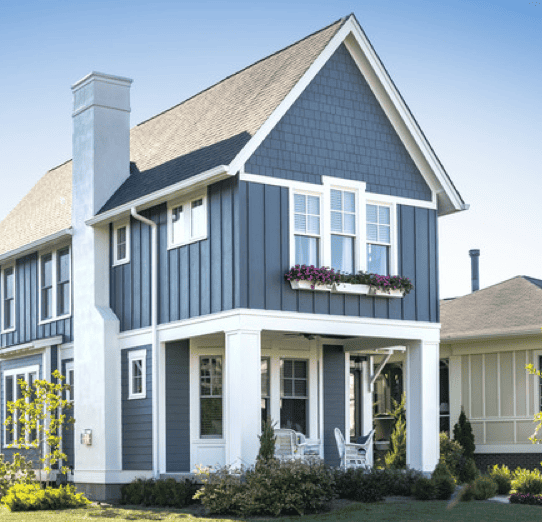Most homeowners only need to replace their siding once in their lifetime. Consequently, it can feel like you’re hearing a foreign language as contractors discuss the siding replacement process with you. Realize contractors will ask about your desires in order to customize your project and achieve the optimal long-term results you deserve.
Familiarizing yourself with the terms that cover the basics of siding replacement is a perfect way to get ready for your home exterior upgrade. It will prepare you to ask smart questions to the contractors you reach out to for a written estimate. And you’ll end up with a better outcome as a result of doing your homework.
Siding Replacement Terms
Want to have confidence when you meet with contractors? Learn the language of residing. Here are some of the common terms you should know before beginning your siding replacement project.
Fascia
The fascia is the attractive board that is visible under your roof’s overhang. It holds up your gutters and makes your roof appear finished. The fascia is also known as a “transition trim” between your home and your roofline. Your home’s fascia supports your shingles and helps keep moisture out.
Frieze
This is an ornamental, horizontal band that appears on the exterior walls of your house, usually near the roofline.
Gables
The triangle-shaped portion of your home exterior that is adjacent to the roof on two sides, gables stabilize a peaked roof.
Soffit
This is the material used to cover the exposed surface beneath the overhang of a roof. (Note: HardieSoffit® Panels come in a variety of textures and venting options.)
Flashing
This is the piece of metal that is installed above windows and doors in order to keep moisture from invading your home.
Lap Siding
Lap siding is horizontal planks that overlap and are also known as clapboard. When lap siding is installed, the boards are nailed in from the bottom up so they overlap. Lap siding comes in a variety of textures, colours, styles and materials. The most popular lap siding material is durable James Hardie fiber cement (known for its durability and beauty). Lap siding also comes in vinyl (a cost-effective siding solution), LP SmartSide Engineered Wood, or traditional wood boards (a material that requires maintenance to keep it in good shape).
Vertical Siding
This popular siding style is made of vertical panels and gives your home a contemporary look. These tall boards come in a variety of textures. Vertical siding can be installed on its own or combined with batten strips to create a different aesthetic.
Shingle Siding
Also called “shake siding,” this is made from separate pieces of siding material (usually low-maintenance fiber cement or genuine wood) and used to achieve a distinct look (perfect for Cape Cod style homes). It is traditionally made of individual pieces of wood in varying widths, creating a rustic appearance.
Board and Batten Siding
This rustic chic look is achieved by using vertical panels (boards) and adding trim or narrow strips (battens) between panels (perfect for Modern Farmhouse style homes).
Finishing Trim
Trim pieces used to provide a finished edge to a siding panel or soffit panel.
House Wrap
Installed under your siding replacement material, this “weather barrier” adds a protective layer to your home exterior and prevents moisture infiltration, while allowing water vapor to escape.
Siding Exposure
Also referred to as “the reveal,” siding exposure is the visible space between the bottoms of adjacent rows of siding. This term is used primarily when describing lap siding. Exposure differs from the total height of your siding planks because rows of horizontal siding slightly overlap each other when they are installed.
Blind Nailing and Face Nailing
Blind nailing is when the fastener drives through the top of the siding plank (keeping the nail out of sight once your siding is installed). Face nailing is when the fastener drives through the overlap at the bottom of the plank (making the nail visible once siding is installed). Note: the James Hardie company recommends blind nailing.
Backerboard
This is the material nailed to the studs on the exterior side of the wall, providing a surface area to fasten the siding and trim.
Buttlock
The piece of siding is located on the opposite side to the fastening strip, which locks into the preceding piece of siding or trim.
Center Butt
This is the bend in the center of a piece of siding that makes the siding appear to be two pieces instead of one.
Face
The portion of a siding panel that is visible after installation; it contributes significantly to your home’s curb appeal.
Weep Holes
This is a hole that has been introduced into a siding panel or trim piece to allow water to drain away from the panel.
Starter Strip
A horizontal strip fastened to the lowest point of the siding installation, this is used to connect the first course of siding to your home’s structure.
Transform Your Home Exterior with New Siding
When siding ages, your home’s protective layer is compromised, making your biggest investment vulnerable to costly damage—like water intrusion. Don’t risk the possibility of suffering damage to your home from moisture or pests. When your home siding becomes compromised, it’s time for a replacement.
Contact us today in regard to your siding or all exterior projects.




